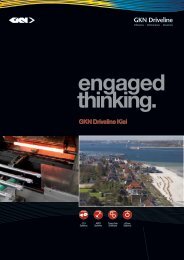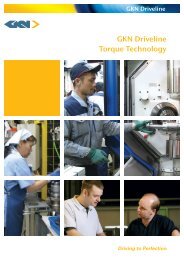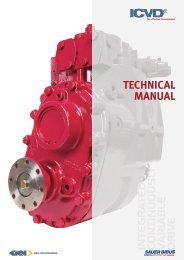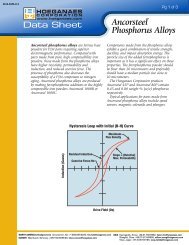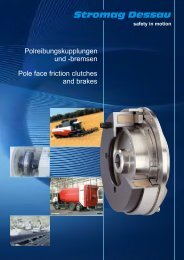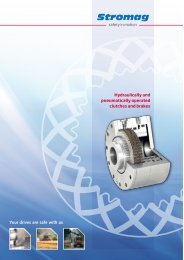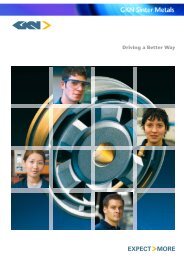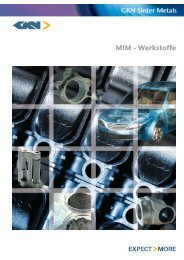aisi grades of stainless steel for pm applications - GKN an
aisi grades of stainless steel for pm applications - GKN an
aisi grades of stainless steel for pm applications - GKN an
You also want an ePaper? Increase the reach of your titles
YUMPU automatically turns print PDFs into web optimized ePapers that Google loves.
STAINLESS STEEL AISI GRADES FOR PMAPPLICATIONSChris SchadeHoeg<strong>an</strong>aes CorporationCinnaminson, NJ 08077John SchaberlAncor SpecialtiesRidgway, PA 15853Al<strong>an</strong> LawleyDrexel UniversityPhiladelphia, PA 19104ABSTRACTApplications requiring <strong>stainless</strong> <strong>steel</strong>s are growing at a rate <strong>of</strong> about 5% <strong>an</strong>nually.Opportunities <strong>for</strong> using powder metallurgy (PM) exist, but additional <strong>grades</strong> not coveredby MPIF St<strong>an</strong>dard 35 are required. The Americ<strong>an</strong> Iron <strong>an</strong>d Steel Institute (AISI) hasst<strong>an</strong>dards <strong>for</strong> a broad r<strong>an</strong>ge <strong>of</strong> <strong>stainless</strong> <strong>steel</strong>s that c<strong>an</strong> be used in m<strong>an</strong>y <strong>applications</strong>, butthe compositions <strong>of</strong> these <strong>grades</strong> must be modified to be conducive to m<strong>an</strong>ufacture byconventional PM techniques. Several <strong>of</strong> these <strong>grades</strong> have been produced as st<strong>an</strong>dardpress <strong>an</strong>d sinter powders. The physical properties, mech<strong>an</strong>ical properties <strong>an</strong>dmicrostructures <strong>of</strong> these various <strong>grades</strong> are reviewed to serve as a guideline <strong>for</strong> PM partsm<strong>an</strong>ufacturers <strong>an</strong>d potential <strong>applications</strong> <strong>of</strong> these <strong>grades</strong> are addressed.INTRODUCTIONMPIF St<strong>an</strong>dard 35 1 lists the most common <strong>grades</strong> <strong>of</strong> <strong>stainless</strong> <strong>steel</strong> used by PM partsm<strong>an</strong>ufacturers. These include austenitic <strong>grades</strong> such as 303L, 304L <strong>an</strong>d 316L, <strong>an</strong>d ferritic<strong>grades</strong> such as 409L, 410L, 430L <strong>an</strong>d 434L. However, with the continued growth <strong>of</strong><strong>stainless</strong> <strong>steel</strong> there exists m<strong>an</strong>y opportunities <strong>for</strong> specialized <strong>stainless</strong> <strong>steel</strong> <strong>grades</strong> notcovered by MPIF St<strong>an</strong>dard 35. These include <strong>applications</strong> requiring enh<strong>an</strong>ced physicalproperties, corrosion resist<strong>an</strong>ce, weldability <strong>an</strong>d machinability. There are additional<strong>grades</strong> covered by the Americ<strong>an</strong> Iron <strong>an</strong>d Steel Institute (AISI) that c<strong>an</strong> be m<strong>an</strong>ufacturedby conventional press <strong>an</strong>d sinter powder metallurgy (PM), Figure 1. The AISIdesignation <strong>for</strong> these alloys is well known with the number series 200 <strong>an</strong>d 300 referringto austenitic <strong>stainless</strong> <strong>steel</strong>s <strong>an</strong>d the 400 series covering the ferritic <strong>an</strong>d martensitic<strong>stainless</strong> <strong>steel</strong>s. Letter designations attached to the end <strong>of</strong> the number series indicatemodifications to the composition. 2 M<strong>an</strong>y societies such as the Society <strong>for</strong> AutomotiveEngineers (SAE) <strong>an</strong>d the Americ<strong>an</strong> Society <strong>for</strong> Testing <strong>an</strong>d Materials (ASTM) use theAISI specification with the latter adding physical property specifications. 3 SAE <strong>an</strong>d
sensitization, particularly in areas adjacent to the weld. Sensitization is the process bywhich chromium combines with carbon to <strong>for</strong>m chromium carbides. The chromium isremoved from areas close to the grain boundaries <strong>an</strong>d leaves these areas depleted <strong>of</strong>chromium, with attend<strong>an</strong>t susceptibility to intergr<strong>an</strong>ular corrosion. The <strong>for</strong>mation <strong>of</strong>chromium carbides is enh<strong>an</strong>ced by temperature <strong>an</strong>d generally occurs in austenitic<strong>stainless</strong> <strong>steel</strong>s at temperatures between 480 o C <strong>an</strong>d 815 o C (900 o F <strong>an</strong>d 1500 o F). Thecooling rate resulting from the welding process is generally slow which increases thelikelihood <strong>of</strong> chromium carbide <strong>for</strong>mation. Increased carbon levels due to insufficientlubric<strong>an</strong>t burn-<strong>of</strong>f c<strong>an</strong> also increase the ch<strong>an</strong>ce <strong>of</strong> sensitization. In order to avoidpostweld heat-treatment, stabilized <strong>grades</strong> <strong>of</strong> austenitic <strong>stainless</strong> <strong>steel</strong>s have beendeveloped.In order to prevent the chromium from <strong>for</strong>ming carbides, strong carbide-<strong>for</strong>mingelements have been added to the austenitic <strong>grades</strong> <strong>of</strong> <strong>stainless</strong> <strong>steel</strong>. In AISI <strong>grades</strong>309Cb, 316Cb <strong>an</strong>d 321L, tit<strong>an</strong>ium <strong>an</strong>d niobium were added <strong>for</strong> this reason. In PMproducts, the use <strong>of</strong> niobium is preferred because water atomization oxidizes the tit<strong>an</strong>ium.Table IV lists the mech<strong>an</strong>ical properties <strong>of</strong> these niobium-stabilized austenitic PM <strong>grades</strong>.In general, due to the addition <strong>of</strong> niobium <strong>an</strong>d the <strong>for</strong>mation <strong>of</strong> carbides, the ductility <strong>an</strong>dimpact toughness <strong>of</strong> these <strong>grades</strong> are slightly lower th<strong>an</strong> those <strong>of</strong> the non-stabilized<strong>grades</strong>. However, in general, this decline in mech<strong>an</strong>ical properties is small, <strong>an</strong>d c<strong>an</strong> becompensated <strong>for</strong> by <strong>an</strong> increase in the level <strong>of</strong> other elements (such as nickel <strong>an</strong>dchromium). Due to the <strong>for</strong>mation <strong>of</strong> the carbides, the creep resist<strong>an</strong>ce <strong>of</strong> these <strong>grades</strong> <strong>of</strong><strong>stainless</strong> <strong>steel</strong> is improved.Table IV: Mech<strong>an</strong>ical Properties <strong>of</strong> PM Austenitic Stainless SteelsImpactGreen SinteredApparentTRSDensity DensityHardnessUTS 0.20% OFFSET ElongationAISI UNS ft.lbs.f (J) (g/cm 3 ) (g/cm 3 ) (ksi) (MPa) (HRB) (ksi) (MPa) (ksi) (MPa) (%)302B S30215 70 94 6.44 6.72 210 1445 56 59 406 32 220 24.8303L S30300 63 84 6.60 6.97 205 1410 48 55 378 28 193 25.4304L S30403 60 80 6.57 6.90 180 1238 55 61 420 35 241 22.4304Cu S30430 64 86 6.73 6.86 129 888 28 55 378 30 206 20.0309Cb S30940 25 34 6.45 6.76 119 819 62 63 433 41 282 14.9310S S31008 38 51 6.42 6.80 139 956 63 61 420 41 282 14.5316L S31603 77 103 6.74 7.13 138 949 56 61 420 32 220 27.0316Cb S31640 73 98 6.56 6.88 137 943 51 51 351 29 200 15.0317L S31703 66 88 6.72 7.01 162 1115 61 70 482 42 289 22.0321L S32100 53 71 6.66 6.90 128 881 57 54 372 32 220 16.2904L N08904 44 59 6.52 6.80 130 894 56 55 378 33 227 14.8Other alloying elements, such as molybdenum, c<strong>an</strong> be added to the austenitic <strong>stainless</strong><strong>steel</strong>s to improve corrosion resist<strong>an</strong>ce. Molybdenum, when added at levels between 2w/o <strong>an</strong>d 4 w/o improves resist<strong>an</strong>ce to oxidation, pitting <strong>an</strong>d crevice corrosion. Theaddition <strong>of</strong> molybdenum also tends to improve both room <strong>an</strong>d high temperatureproperties such as tensile strength <strong>an</strong>d creep. The mech<strong>an</strong>ical properties <strong>of</strong> AISI 317L arecited in Table IV <strong>an</strong>d the corrosion resist<strong>an</strong>ce is illustrated in Figure 3. Currently PMfabricators sinter austenitic <strong>grades</strong> in a hydrogen/nitrogen atmosphere to increase strength(MPIF St<strong>an</strong>dard 35: <strong>grades</strong> SS-304N <strong>an</strong>d SS-316N). In so doing, signific<strong>an</strong>t chromiumnitride <strong>for</strong>mation occurs, which is detrimental to the overall corrosion resist<strong>an</strong>ce <strong>of</strong> thealloy. The addition <strong>of</strong> molybdenum is beneficial if both corrosion resist<strong>an</strong>ce <strong>an</strong>d strengthare required.
(a) (b) (c)Figure 3. Representative appear<strong>an</strong>ce <strong>of</strong> salt spray specimens: (a.) 304L, (b.) 316L, (c.) 317L.More highly alloyed 300 series <strong>stainless</strong> <strong>steel</strong>s are available that are designed to resistoxidation at high temperatures while maintaining a high degree <strong>of</strong> tensile strength <strong>an</strong>dcreep resist<strong>an</strong>ce. These alloys rely on the <strong>for</strong>mation <strong>of</strong> the chromium oxide film <strong>for</strong>protection from corrosion, but the additional nickel <strong>an</strong>d silicon in these alloys helps t<strong>of</strong>orm a more ductile scale, which increases its adherence to the base metal. The adherentscale is particularly import<strong>an</strong>t when service conditions involve cyclic temperatures. Theproperties <strong>of</strong> several <strong>of</strong> these PM <strong>grades</strong> (302B, 304L <strong>an</strong>d 310L) are listed in Table IV<strong>an</strong>d the relative oxidation resist<strong>an</strong>ce <strong>of</strong> these <strong>grades</strong> is shown in Figure 4.1.41.21304L302B310L% <strong>of</strong> Initial Weight0.80.60.40.20600 700 800 900 1000 1100 1200Temperature ( o C)Figure 4. Oxidation <strong>of</strong> 300 series <strong>stainless</strong> <strong>steel</strong>s.
As with the other categories <strong>of</strong> <strong>stainless</strong> <strong>steel</strong>s, there exists “super austenitics” whereincreased levels <strong>of</strong> nickel, copper, <strong>an</strong>d molybdenum provide superior or specializedcorrosion resist<strong>an</strong>ce. However, <strong>for</strong> the PM <strong>grades</strong> <strong>of</strong> these alloys the increased alloycontent has a negative impact on powder compressibility <strong>an</strong>d there<strong>for</strong>e on overall density.In consequence, care has to be taken to ensure that the increased corrosion resist<strong>an</strong>ce <strong>an</strong>denh<strong>an</strong>ced mech<strong>an</strong>ical properties gained by the increase in alloy content are not <strong>of</strong>fset by areduction in achievable density. Type 904 <strong>stainless</strong> <strong>steel</strong> is considered a “superaustenitic” <strong>stainless</strong> <strong>steel</strong>.Martensitic Stainless SteelsMartensitic <strong>steel</strong>s in the 400 series are similar to the ferritic <strong>stainless</strong> <strong>steel</strong>s in that theycontain chromium in the r<strong>an</strong>ge <strong>of</strong> 11 w/o to 18 w/o but also contain other elements suchas nickel Table V. The martensitic <strong>stainless</strong> <strong>steel</strong>s are magnetic <strong>an</strong>d are generally used in<strong>applications</strong> where hardness <strong>an</strong>d/or wear resist<strong>an</strong>ce is required. When heat-treated theyc<strong>an</strong> achieve high strength <strong>an</strong>d when tempered, they c<strong>an</strong> exhibit some ductility.Essentially, these <strong>steel</strong>s achieve mech<strong>an</strong>ical properties comparable with those <strong>of</strong> a heattreatablelow alloy <strong>steel</strong> but with enh<strong>an</strong>ced corrosion resist<strong>an</strong>ce, although their corrosionresist<strong>an</strong>ce is the lowest <strong>of</strong> <strong>an</strong>y <strong>of</strong> the <strong>stainless</strong> <strong>steel</strong> categories. MPIF st<strong>an</strong>dard 35recognizes SS-410-90HT as a martensitic alloy. For this grade, the sintering atmospherecontains a high level <strong>of</strong> nitrogen, <strong>an</strong>d the alloys <strong>for</strong>m high temperature austenite, whichtr<strong>an</strong>s<strong>for</strong>ms to martensite on cooling.Table V: Composition <strong>of</strong> PM Martensitic Stainless Steels (w/o)AISI UNS C S Si Cr Ni Cu Mo Nb414 M S414000.03 .030 1.0 12.0 1.25 .50 .50Max. Max. Max. 15.0 2.50 Max. Max.---414 M S414260.03 .030 1.0 12.0 4.0 1.5 1.5Max. Max. Max. 15.0 7.0 2.0 2.0---415 M S415000.03 .030 1.0 11.5 3.5 .50 .5Max. Max. Max. 14.0 5.5 Max. 1.0---420 M S42000.15 .030 1.0 12.0 .50 .50 .50.30 Max. Max. 14.0 Max. Max. Max.---440B MS440030.75 .030 1.0 16.0 .50 .50 .750.95 Max. Max. 18.0 Max. Max. Max.---440C MS440040.95 .030 1.0 16.0 .50 .50 .751.20 Max. Max. 18.0 Max. Max. Max.---410LCu J911510.15 .030 1.5 11.5 1.0 3.0 .50Max. Max. Max. 14.0 Max. 5.0 Max.---M Designates material made from a mix <strong>of</strong> a base powder <strong>an</strong>d additives such as nickel, graphite, copper <strong>an</strong>dmolybdenum.Other AISI martensitic <strong>grades</strong> <strong>of</strong> <strong>stainless</strong> <strong>steel</strong>, such as 420,440A, 440B <strong>an</strong>d 440C, c<strong>an</strong>be processed by adding graphite to ferritic <strong>grades</strong> <strong>of</strong> <strong>stainless</strong> <strong>steel</strong>s such as 410L <strong>an</strong>d430L. Table VI gives the properties <strong>of</strong> 420L, 440B <strong>an</strong>d 440C made by this approach.The level <strong>of</strong> carbon added to the alloy dictates the mech<strong>an</strong>ical properties <strong>of</strong> themartensitic <strong>stainless</strong> <strong>steel</strong>. The higher the carbon content, the larger the extent <strong>of</strong>
chromium carbide <strong>for</strong>mation, <strong>an</strong>d the higher the strength <strong>an</strong>d apparent hardness <strong>of</strong> thealloy.Table VI: Mech<strong>an</strong>ical Properties <strong>of</strong> PM Martensitic Stainless SteelsImpactGreen SinteredApparentTRSDensity DensityHardnessUTS 0.20% OFFSET ElongationAISI UNS ft.lbs.f (J) (g/cm 3 ) (g/cm 3 ) (ksi) (MPa) (HRB) (ksi) (MPa) (ksi) (MPa) (%)410LCu J91151 13 17 6.43 6.84 249 1713 95 116 798 89 612 2.7414 S41400 50 67 6.55 6.95 223 1534 90 98 674 75 516 3.7414 S41426 21 28 6.62 7.00 209 1438 89 100 688 76 523 2.5415 M S41500 26 35 6.69 7.03 253 1741 96 108 743 80 550 2.9415 PA S41500 11 15 6.17 6.52 178 1225 83 98 674 73 502 2.3420 S42000 24 32 6.68 6.86 172 1183 67 57 392 37 255 2.2440B S44003 20 27 6.58 6.82 134 922 93 67 461 42 289 2.0440B HT S44003 3 4 6.58 6.76 128 881 29/c 74 509 70 482 0.6440C S44004 13 17 5.56 6.91 169 1163 94 79 544 61 420 2.2440C HT S44004 3 4 5.56 6.90 155 1066 37/c 65 447 62 427 0.6MAISI 415 = Powder Mix, AISI PA = Prealloy.A major drawback to carbon-containing martensitic <strong>stainless</strong> <strong>steel</strong>s is their relatively poorcorrosion resist<strong>an</strong>ce <strong>an</strong>d ductility. Low carbon-containing martensitic <strong>stainless</strong> <strong>steel</strong>s c<strong>an</strong>be produced by adding nickel, molybdenum <strong>an</strong>d copper to <strong>for</strong>m martensitic <strong>stainless</strong><strong>steel</strong>s with improved toughness <strong>an</strong>d corrosion resist<strong>an</strong>ce. Table V cites the composition<strong>of</strong> several martensitic <strong>stainless</strong> <strong>steel</strong>s made by adding nickel, copper <strong>an</strong>d molybdenum.Nickel <strong>an</strong>d copper are austenite <strong>for</strong>mers, while molybdenum improves properties viasolid solution strengthening; this element is responsible <strong>for</strong> improving high temperatureproperties. While the apparent hardness <strong>of</strong> these alloys is slightly inferior to that <strong>of</strong> heattreatedcarbon-containing martensitic <strong>stainless</strong> <strong>steel</strong>s, other mech<strong>an</strong>ical properties such astensile strength, toughness <strong>an</strong>d ductility are superior. These <strong>grades</strong> <strong>of</strong> <strong>stainless</strong> <strong>steel</strong> alsoexhibit superior corrosion resist<strong>an</strong>ce which reflects the absence <strong>of</strong> carbide <strong>for</strong>mation <strong>an</strong>dhence sensitization, as shown in Figure 5.(a) (b) (c)(d)(e)Figure 5. Representative appear<strong>an</strong>ce <strong>of</strong> salt spray specimen s: (a.) 440B, (b.) 440C, (c.) 410Lcu,(d.) super-martensitic admixed, (e.) super-martensitic prealloyed
As with other categories <strong>of</strong> <strong>stainless</strong> <strong>steel</strong>s, super-martensitic <strong>stainless</strong> <strong>steel</strong>s c<strong>an</strong> be<strong>for</strong>med by adding high levels <strong>of</strong> nickel, copper <strong>an</strong>d molybdenum. For PM alloys theprealloyed materials are usually low in compressibility but c<strong>an</strong> exhibit superior corrosionresist<strong>an</strong>ce due to their high alloy content.Precipitation-Hardening Stainless SteelsPrecipitation hardening <strong>stainless</strong> <strong>steel</strong>s are not defined by their microstructure, but ratherby strengthening mech<strong>an</strong>ism. These <strong>grades</strong> may have austenitic, semi-austenitic ormartensitic microstructures <strong>an</strong>d c<strong>an</strong> be hardened by aging at moderately elevatedtemperatures, 480 o C to 620 o C (900 o F to 1150 o F). The strengthening effect is due tothe <strong>for</strong>mation <strong>of</strong> intermetallic precipitates from elements such as copper or aluminum.These alloys generally have high strength <strong>an</strong>d high apparent hardness while exhibitingsuperior corrosion resist<strong>an</strong>ce compared with martensitic <strong>stainless</strong> <strong>steel</strong>s. Heat treatmentsc<strong>an</strong> be used to vary the properties <strong>of</strong> the alloys <strong>an</strong>d involve short times (1 h) attemperatures r<strong>an</strong>ging from 480 o C to 620 o C (900 o F to 1150 o F). The aging treatment c<strong>an</strong>take place in either air or in nitrogen, depending on the surface appear<strong>an</strong>ce required.However, these alloys should not be subjected to welding or in service temperaturesabove the heat-treatment temperature because strength c<strong>an</strong> be lost due to overaging.The AISI designation <strong>for</strong> these alloys is the 600 series <strong>of</strong> <strong>stainless</strong> <strong>steel</strong>s, but most aremore commonly known by their alloy name, <strong>for</strong> example, 15-5PH, 17-4PH <strong>an</strong>d17-7PH.The aluminum-containing precipitation hardening alloys are difficult to process by thePM route due to their high affinity <strong>for</strong> nitride <strong>for</strong>mation <strong>an</strong>d the difficulty in reducingaluminum oxide during sintering.Table VII <strong>an</strong>d VIII give the chemical compositions <strong>an</strong>d mech<strong>an</strong>ical properties <strong>of</strong> severalprecipitation hardening alloys produced by conventional PM techniques. 17-4PH is amartensitic grade in which ductility <strong>an</strong>d toughness are generally higher th<strong>an</strong> in thecarbon-containing martenstitc <strong>grades</strong>. The mech<strong>an</strong>ical properties <strong>of</strong> 17-4PH c<strong>an</strong> beincreased by 15% by aging at 538 o C (1000 o F) <strong>for</strong> 1 h. Applications <strong>for</strong> this alloy existin the food, chemical <strong>an</strong>d aerospace industries.Table VII: Composition <strong>of</strong> PM Precipitation Hardening Stainless Steels (w/o)AISIUNS C S Si Cr Ni Cu Mo17-4PHS174000.03 .030 1.0 15.0 3.0 3.0 .50Max. Max. Max. 17.0 5.0 5.0 Max.410LCu J91151.15 .030 1.0 12.0 .50 .50 .50.30 Max. Max. 14.0 Max. Max. Max.633 M S350000.07 .030 1.0 16.0 4.0 .50 2.500.11 Max. Max. 17.0 5.0 Max. 3.25Nb.15.45------633 is a semi-austenitic precipitation hardening <strong>stainless</strong> <strong>steel</strong> <strong>of</strong>fering improvedcorrosion resist<strong>an</strong>ce compared with martensitic precipitation hardening alloys. Thesealloys are used <strong>for</strong> parts requiring high strength at moderately elevated temperatures.Depending on the aging treatment, the ductility <strong>an</strong>d toughness <strong>of</strong> this alloy c<strong>an</strong> approach
those <strong>of</strong> the austenitic <strong>stainless</strong> <strong>steel</strong>s. The microstructure <strong>of</strong> the alloy is a mixture <strong>of</strong>austenite, martensite <strong>an</strong>d small qu<strong>an</strong>tities <strong>of</strong> ferrite.Table VIII: Mech<strong>an</strong>ical Properties <strong>of</strong> PM Precipitation Hardening Stainless SteelsImpactGreen SinteredApparentTRSDensity DensityHardnessUTS 0.20% OFFSET ElongationAISI UNS ft.lbs.f (J) (g/cm 3 ) (g/cm 3 ) (ksi) (MPa) (HRB) (ksi) (MPa) (ksi) (MPa) (%)17-4PH S17400 10 13 6.39 6.66 220 1514 81 92 633 60 413 2.817-4PH Aged S17400 6 8 6.39 6.66 273 1878 93 119 819 100 688 1.7410LCu J91151 21 28 6.50 6.98 219 1507 88 99 681 76 523 3410LCu Aged J91151 22 29 6.50 6.98 245 1686 94 113 777 94 647 3.5633 S35000 65 87 6.57 7.23 218 1500 94 111 764 63 433 4.5633 AGED S35000 67 90 6.57 7.24 265 1823 96 113 777 85 585 8.7Usage <strong>of</strong> the precipitation-hardening alloys is generally limited by the high cost <strong>of</strong> thealloying elements. Recently, a lower cost PM precipitation hardening alloy has beenintroduced based on UNS J91151 (a cast grade). 10 This alloy has only 13 w/o chromium<strong>an</strong>d utilizes the precipitation <strong>of</strong> copper to provide a low cost-high strength alloy withmoderate corrosion resist<strong>an</strong>ce. Table VIII shows that the mech<strong>an</strong>ical properties approachthose <strong>of</strong> 17-4PH, while still maintaining a level <strong>of</strong> corrosion resist<strong>an</strong>ce that is better th<strong>an</strong>that <strong>of</strong> the high carbon martensitic <strong>grades</strong>.Duplex Stainless SteelsTable IX: Composition <strong>of</strong> PM Duplex/Dual Phase Stainless Steels (w/o)AISI UNS C S Si Cr Ni Cu Mo NbDuplex- 329 M S329000.08 .030 1.0 23.0 2.5 .50 1.00Max. Max. Max. 28.0 5.0 Max. 2.00---Duplex- 2205 S322050.03 .030 1.0 21.0 4.5 3.0 2.50Max. Max. Max. 23.0 6.5 5.0 3.50---Duracor/3Cr12 S41003.15 .030 1.0 10.5 1.50 .50 .50.30 Max. Max. 12.5 Max. Max. Max.---Technically, duplex <strong>steel</strong>s are <strong>stainless</strong> <strong>steel</strong>s that contain two phases. 3 Duplex <strong>stainless</strong><strong>steel</strong>s are more-accurately defined as alloys containing a mixed microstructure <strong>of</strong> ferrite<strong>an</strong>d austenite. New alloys being developed that contain mixtures <strong>of</strong> ferrite <strong>an</strong>d martensiteare generally termed dual-phase. 11 Compositions <strong>of</strong> PM Duplex/Dual Phase <strong>stainless</strong><strong>steel</strong>s are listed in Table IX. A major adv<strong>an</strong>tage <strong>of</strong> these <strong>stainless</strong> <strong>steel</strong> <strong>grades</strong> is that eachphase imparts improved properties to the alloy.
(a)(b)Figure 6. Representative microstructures <strong>of</strong> (a) duplex <strong>stainless</strong> <strong>steel</strong>: (b) dual-phase <strong>stainless</strong> <strong>steel</strong>.Duplex <strong>stainless</strong> <strong>steel</strong>s are ferritic <strong>stainless</strong> <strong>steel</strong>s (Figure 6(a)) containing chromium <strong>an</strong>dmolybdenum to which austenite <strong>for</strong>mers (primarily nickel) have been added to ensurethat austenite is present at room temperature. Duplex <strong>stainless</strong> <strong>steel</strong>s have severaladv<strong>an</strong>tages over the austenitic <strong>grades</strong> including high strength, acceptable toughness, <strong>an</strong>dsuperior corrosion resist<strong>an</strong>ce, particularly to chloride stress corrosion cracking. Themech<strong>an</strong>ical properties <strong>of</strong> a duplex <strong>stainless</strong> <strong>steel</strong> (2205) are shown in Table X.Table X: Mech<strong>an</strong>ical Properties <strong>of</strong> PM Duplex/Dual Phase Stainless SteelsGreen SinteredApparentImpactTRS UTS 0.20% OFFSET ElongationDensity DensityHardnessAISI UNS ft.lbs.f (J) (g/cm 3 ) (g/cm 3 ) (ksi) (MPa) (HRB) (ksi) (MPa) (ksi) (MPa) (%)Duplex- 329 M S32900 46 62 6.27 7.07 179 1232 50 76 523 67 461 7.7Duplex- 2205 S32205 82 110 6.48 7.20 202 1390 81 84 578 62 427 10.8Duracor/3Cr12 S41003 49 66 6.62 7.34 278 1913 88 107 736 82 564 3.1Dual phase <strong>stainless</strong> <strong>steel</strong>s vary in composition but are generally non-austenitic (Figure6(b)) <strong>an</strong>d magnetic, containing 11 w/o Cr. The chemistry <strong>of</strong> the alloy is bal<strong>an</strong>ced byferrite <strong>for</strong>mers <strong>an</strong>d austenite <strong>for</strong>mers. The austenite tr<strong>an</strong>s<strong>for</strong>ms to martensite upon coolingresulting in a mixture <strong>of</strong> ferrite <strong>an</strong>d martensite. Because <strong>of</strong> the low cost <strong>of</strong> the alloy it isused as a replacement <strong>for</strong> plain carbon <strong>steel</strong>s where increased corrosion resist<strong>an</strong>ce isneeded. The martensite in the alloy allows the material to be used in <strong>applications</strong>requiring strength <strong>an</strong>d wear resist<strong>an</strong>ce. The properties <strong>of</strong> a PM version <strong>of</strong> this <strong>stainless</strong><strong>steel</strong> (S41003) are cited in Table X.FATIGUE BEHAVIOR OF PM STAİNLESS STEELSFatigue tests were per<strong>for</strong>med on some <strong>of</strong> the high strength PM alloys developed. The results <strong>of</strong>these tests,in terms <strong>of</strong> the 90% survival limit, are compared with those <strong>of</strong> other <strong>stainless</strong> <strong>steel</strong>fatigue data by Shah et al. 12 in Figure 7. The latter study study compared the fatigue strength <strong>of</strong>various <strong>stainless</strong> <strong>steel</strong>s as a function <strong>of</strong> tensile strength.
Fatigue Endur<strong>an</strong>ce Limit (KSI)504540353025201510500 100 200 300 400 500 600 700 800 900430L434L410L409LE434N430N2Tensile Strength (MPa)DUPLEX409LNi409LNi-HC40 50 60 70 80 90 100 110 120 130 140420Tensile Strength (KSI)410HT17-4PHDual Phase410LCuAged410LCuMartensiticFigure 7. Fatigue endur<strong>an</strong>ce limit (90% survival) as a function <strong>of</strong> tensile strength.The excellent fatigue response <strong>of</strong> these alloys is attributed to their high tensile strength.In general, fatigue crack propagation rates in PM <strong>steel</strong>s are high <strong>an</strong>d the fatigue limit isdictated by crack initiation rather th<strong>an</strong> by crack propagation. Resist<strong>an</strong>ce to crackinitiation increases as the tensile strength increases. All the PM alloys included in Figure7 have high tensile strengths, <strong>an</strong>d there<strong>for</strong>e high fatigue endur<strong>an</strong>ce limits. It appears thatthe addition <strong>of</strong> copper, nickel, <strong>an</strong>d molybdenum, results in harder martensite, which has apositive effect on fatigue strength.3452952451951459545-5Fatique Endur<strong>an</strong>ce Limit MPa)CONCLUSIONS• M<strong>an</strong>y AISI <strong>grades</strong> <strong>of</strong> <strong>stainless</strong> <strong>steel</strong> c<strong>an</strong> be made via conventional wateratomization <strong>an</strong>d press <strong>an</strong>d sinter PM. These <strong>grades</strong> are not currently covered byMPIF St<strong>an</strong>dard 35, but provide a r<strong>an</strong>ge <strong>of</strong> properties <strong>an</strong>d corrosion resist<strong>an</strong>ce thatc<strong>an</strong> lead to increased opportunities <strong>for</strong> PM parts producers.• These PM <strong>grades</strong> c<strong>an</strong> be made as prealloys, or admixed nickel, copper <strong>an</strong>dmolybdenum powders c<strong>an</strong> be added to the base <strong>stainless</strong> <strong>steel</strong>.• In ferritic <strong>grades</strong>, higher levels <strong>of</strong> chromium, niobium <strong>an</strong>d sulfur c<strong>an</strong> lead toimproved mech<strong>an</strong>ical properties, corrosion resist<strong>an</strong>ce <strong>an</strong>d machinability.• The addition <strong>of</strong> carbon to low chromium PM alloys results in martensitic <strong>stainless</strong><strong>steel</strong>s with increased strength <strong>an</strong>d apparent hardness. Additions <strong>of</strong> nickel, copper
<strong>an</strong>d molybdenum produce low carbon martensitic <strong>stainless</strong> <strong>steel</strong>s with increasedtoughness <strong>an</strong>d corrosion resist<strong>an</strong>ce.• Niobium, when added to PM austenitic <strong>stainless</strong> <strong>steel</strong>s, improves weldability.Increases in the molybdenum content <strong>of</strong> austenitic <strong>stainless</strong> <strong>steel</strong>s c<strong>an</strong> increasestrength <strong>an</strong>d enh<strong>an</strong>ce corrosion resist<strong>an</strong>ce. Increases in chromium, nickel <strong>an</strong>dsilicon levels enh<strong>an</strong>ce oxidation resist<strong>an</strong>ce.• Several precipitation hardening alloys with a r<strong>an</strong>ge <strong>of</strong> mech<strong>an</strong>ical properties,microstructure <strong>an</strong>d attend<strong>an</strong>t corrosion resist<strong>an</strong>ce c<strong>an</strong> be produced byconventional PM processes.• Mixed microstructure <strong>stainless</strong> <strong>steel</strong>s exhibiting excellent mech<strong>an</strong>ical properties<strong>an</strong>d corrosion resist<strong>an</strong>ce c<strong>an</strong> be produced by conventional PM processes.• Fatigue response <strong>of</strong> the high strength PM alloys is a function <strong>of</strong> their tensilestrength.REFERENCES1. Materials St<strong>an</strong>dards <strong>for</strong> PM Structural Parts, 2007, Metal Powder IndustriesFederation, Princeton, NJ.2. J.R. Davis, Alloying: Underst<strong>an</strong>ding the Basics, 2001, ASM International, MaterialsPark OH.3. J. Beddoes <strong>an</strong>d J. G. Parr, Introduction to Stainless Steels, 1999, ASM International,Materials Park, OH.4. J.D. Redmond, Metals <strong>an</strong>d Alloys in the Unified Numbering System, 10 th Edition,2004, Joint Publication <strong>of</strong> the Society <strong>of</strong> Automotive Engineers, Inc. <strong>an</strong>d theAmeric<strong>an</strong> Society <strong>for</strong> Testing <strong>an</strong>d Materials.5. J.E. Bringas, Stainless Steel Data Book, 1992, CASTI Publishing Inc., Edmonton,Alberta, C<strong>an</strong>ada.6. H. Cobb, Steel Products M<strong>an</strong>ual- Stainless Steels, 1999, Iron <strong>an</strong>d Steel Society,Warrendale, PA.7. T.R. Albee, P. DePoutil<strong>of</strong>f, G. Ramsey <strong>an</strong>d G.E. Reg<strong>an</strong>, “Enh<strong>an</strong>ced Powder MetalMaterials <strong>for</strong> Exhaust System Applications,” SAE Paper No. 970281, SAEInternational, Warrendale, PA, USA.1997.8. T. Hubbard, K. Couchm<strong>an</strong> <strong>an</strong>d C. Lall, “Per<strong>for</strong>m<strong>an</strong>ce <strong>of</strong> Stainless Steel PM Materialsin elevated Temperature Applications,” SAE Paper No. 970422, SAE International,Warrendale, PA, USA.1997.9. R.J. Causton, T. Cimino-Corey, <strong>an</strong>d C.T. Schade “Improved Stainless Steel ProcessRoutes,” Adv<strong>an</strong>ces in Powder Metallurgy <strong>an</strong>d Particulate Materials – 2003, compiledby R. Lawcock <strong>an</strong>d M. Wright, Metal Powder Industries Federation, Princeton, NJ,2003, part 2 pp.1-13.10. A. Lawley, R.Doherty, P. Stears <strong>an</strong>d C.T. Schade, “Precipitation Hardening StainlessSteels,” Adv<strong>an</strong>ces in Powder Metallurgy <strong>an</strong>d Particulate Materials – 2006, compiled
y W. R. Gasbarre <strong>an</strong>d J.W. von Arx, Metal Powder Industries Federation, Princeton,NJ, 2006, part 7 pp.141-153.11. A. Lawley, E. Wagner, <strong>an</strong>d C.T. Schade, “Develo<strong>pm</strong>ent <strong>of</strong> a High-Strength-Dual-Phase P/M Stainless Steel,” Adv<strong>an</strong>ces in Powder Metallurgy <strong>an</strong>d ParticulateMaterials – 2005, compiled by C. Ruas <strong>an</strong>d T. Tomlin, Metal Powder IndustriesFederation, Princeton, NJ, 2005, part 7 pp.78-89.12. S.O. Shah, J.R. McMillen, P.K. Samal <strong>an</strong>d L.F. Pease, “Mech<strong>an</strong>ical Properties <strong>of</strong>High Temperature Sintered P/M 409LE <strong>an</strong>d 409LNi Stainless Steels Utilized in theM<strong>an</strong>ufacturing <strong>of</strong> Exhaust Fl<strong>an</strong>ges <strong>an</strong>d Oxygen Sensor Bosses,” SAE Paper No.2003-01-0451, SAE International, Warrendale, PA 15096, USA, 2003.



